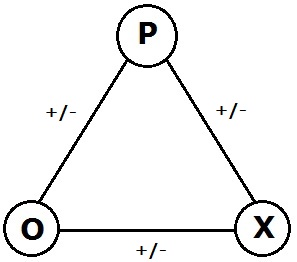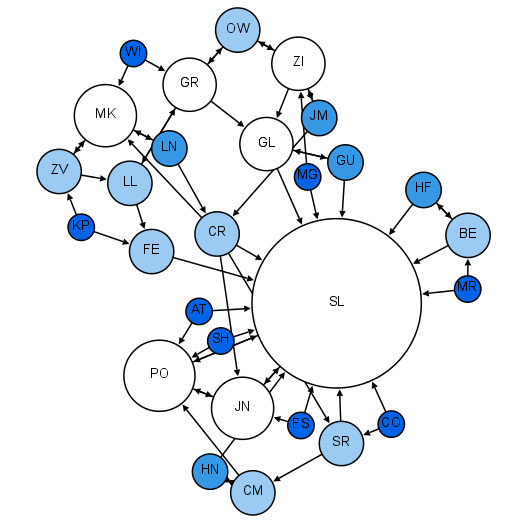|
Triadic Closure
Triadic closure is a concept in social network theory, first suggested by German sociologist Georg Simmel in his 1908 book ''Soziologie'' 'Sociology: Investigations on the Forms of Sociation'' Triadic closure is the property among three nodes A, B, and C (representing people, for instance), that if the connections A-B and A-C exist, there is a tendency for the new connection B-C to be formed. Triadic closure can be used to understand and predict the growth of networks, although it is only one of many mechanisms by which new connections are formed in complex networks. Easley, David; Kleinberg, Jon (2010). ''Networks, crowds, and markets: reasoning about a highly connected world''. Cambridge: Cambridge University Press. . History Triadic closure was made popular by Mark Granovetter in his 1973 article ''The Strength of Weak Ties''.Granovetter, M. (1973).The Strength of Weak Ties", American Journal of Sociology, Vol. 78, Issue 6, May 1360-80. There he synthesized the theory of co ... [...More Info...] [...Related Items...] OR: [Wikipedia] [Google] [Baidu] [Amazon] |
Cambridge University Press
Cambridge University Press was the university press of the University of Cambridge. Granted a letters patent by King Henry VIII in 1534, it was the oldest university press in the world. Cambridge University Press merged with Cambridge Assessment to form Cambridge University Press and Assessment under Queen Elizabeth II's approval in August 2021. With a global sales presence, publishing hubs, and offices in more than 40 countries, it published over 50,000 titles by authors from over 100 countries. Its publications include more than 420 academic journals, monographs, reference works, school and university textbooks, and English language teaching and learning publications. It also published Bibles, runs a bookshop in Cambridge, sells through Amazon, and has a conference venues business in Cambridge at the Pitt Building and the Sir Geoffrey Cass Sports and Social Centre. It also served as the King's Printer. Cambridge University Press, as part of the University of Cambridge, was a ... [...More Info...] [...Related Items...] OR: [Wikipedia] [Google] [Baidu] [Amazon] |
Social Systems
In sociology, a social system is the patterned network of relationships constituting a coherent whole that exist between individuals, groups, and institutions. It is the formal Social structure, structure of role and status that can form in a small, stable group. An individual may belong to multiple social System, systems at once; examples of social systems include nuclear family units, community, communities, City, cities, nations, college campuses, religions, corporations, and Industry (economics), industries. The organization and definition of groups within a social system depend on various shared properties such as location, Socioeconomics, socioeconomic status, race, religion, societal function, or other distinguishable features. Notable theorists The study of social systems is integral to the fields of sociology and public policy. Social systems have been studied for as long as sociology has existed. Talcott Parsons Talcott Parsons was the first to formulate a systematic ... [...More Info...] [...Related Items...] OR: [Wikipedia] [Google] [Baidu] [Amazon] |
Social Networks
A social network is a social structure consisting of a set of social actors (such as individuals or organizations), networks of dyadic ties, and other social interactions between actors. The social network perspective provides a set of methods for analyzing the structure of whole social entities along with a variety of theories explaining the patterns observed in these structures. The study of these structures uses social network analysis to identify local and global patterns, locate influential entities, and examine dynamics of networks. For instance, social network analysis has been used in studying the spread of misinformation on social media platforms or analyzing the influence of key figures in social networks. Social networks and the analysis of them is an inherently interdisciplinary academic field which emerged from social psychology, sociology, statistics, and graph theory. Georg Simmel authored early structural theories in sociology emphasizing the dynamics of tria ... [...More Info...] [...Related Items...] OR: [Wikipedia] [Google] [Baidu] [Amazon] |
Degree (graph Theory)
In graph theory, the degree (or valency) of a vertex of a graph is the number of edges that are incident to the vertex; in a multigraph, a loop contributes 2 to a vertex's degree, for the two ends of the edge. The degree of a vertex v is denoted \deg(v) or \deg v. The maximum degree of a graph G is denoted by \Delta(G), and is the maximum of G's vertices' degrees. The minimum degree of a graph is denoted by \delta(G), and is the minimum of G's vertices' degrees. In the multigraph shown on the right, the maximum degree is 5 and the minimum degree is 0. In a regular graph, every vertex has the same degree, and so we can speak of ''the'' degree of the graph. A complete graph (denoted K_n, where n is the number of vertices in the graph) is a special kind of regular graph where all vertices have the maximum possible degree, n-1. In a signed graph, the number of positive edges connected to the vertex v is called positive deg(v) and the number of connected negative edges is enti ... [...More Info...] [...Related Items...] OR: [Wikipedia] [Google] [Baidu] [Amazon] |
Clustering Coefficient
In graph theory, a clustering coefficient is a measure of the degree to which nodes in a graph tend to cluster together. Evidence suggests that in most real-world networks, and in particular social networks, nodes tend to create tightly knit groups characterised by a relatively high density of ties; this likelihood tends to be greater than the average probability of a tie randomly established between two nodes (Holland and Leinhardt, 1971; Watts and Strogatz, 1998). Two versions of this measure exist: the global and the local. The global version was designed to give an overall indication of Clustering_coefficient#Global_clustering_coefficient, the clustering in the network, whereas the local gives an indication of the Clustering_coefficient#Local_clustering_coefficient, extent of "clustering" of a single node. Local clustering coefficient The local clustering coefficient of a vertex (graph theory), vertex (node) in a Graph (discrete mathematics), graph quantifies how close its ... [...More Info...] [...Related Items...] OR: [Wikipedia] [Google] [Baidu] [Amazon] |
Fritz Heider
Fritz Heider (19 February 1896 – 2 January 1988) was an Austrian psychologist whose work was related to the Gestalt school. In 1958 he published ''The Psychology of Interpersonal Relations'', which expanded upon his creations of balance theory and attribution theory. This book presents a wide-range analysis of the conceptual framework and the psychological processes that influence human social perception (Malle, 2008). It had taken 15 years to complete; before it was completed it had already circulated through a small group of social psychologists. Biography Heider was born in Vienna on February 19, 1896, but he grew up in Graz. During his childhood, Heider sustained a serious eye injury which later turned him quite serious and shy in his adolescence. Because of his injury, Heider avoided the draft during World War I. With his father's encouragement, Heider enrolled to study architecture at the University of Graz. After growing tired of studying architecture, Heider attem ... [...More Info...] [...Related Items...] OR: [Wikipedia] [Google] [Baidu] [Amazon] |
Cognitive Balance
In the psychology of motivation, balance theory is a theory of attitude change, proposed by Fritz Heider. It conceptualizes the cognitive consistency motive as a drive toward psychological balance. The consistency motive is the urge to maintain one's values and beliefs over time. Heider proposed that "sentiment" or liking relationships are balanced if the affect valence in a system multiplies out to a positive result. Research in 2020 provided neuroscientific evidence supporting Heider's balance theory. A study using neuroimaging techniques found distinct differences in brain activation when individuals were exposed to unbalanced versus balanced triads. These differences were observed in brain regions associated with processing cognitive dissonance, offering biological support for Heider's original psychological explanation of balance theory in social context. Structural balance theory in social network analysis is the extension proposed by Dorwin Cartwright and Frank Harary. ... [...More Info...] [...Related Items...] OR: [Wikipedia] [Google] [Baidu] [Amazon] |
Mark Granovetter
Mark Sanford Granovetter (; born October 20, 1943) is an American sociologist and professor at Stanford University. He is best known for his work in social network theory and in economic sociology, particularly his theory on the spread of information in social networks known as ''The Strength of Weak Ties'' (1973). In 2014 Granovetter was named a Citation Laureate by Thomson Reuters and added to that organization's list of predicted Nobel Prize winners in economics. Data from the Web of Science show that Granovetter has written both the first and third most cited sociology articles. Education Granovetter earned a Bachelor of Arts degree in history at Princeton University (1965) and a PhD in sociology at Harvard University (1970). At Harvard his research was supervised by Harrison White. Career and research Granovetter has been the Joan Butler Ford Professor in the School of Humanities and Sciences at Stanford since at least 2005, and has chaired of the Department of Sociolog ... [...More Info...] [...Related Items...] OR: [Wikipedia] [Google] [Baidu] [Amazon] |
Jon Kleinberg
Jon Michael Kleinberg (born 1971) is an American computer scientist and the Tisch University Professor of Computer Science and Information Science at Cornell University known for his work in algorithms and networks. He is a recipient of the Nevanlinna Prize by the International Mathematical Union. Early life and education Jon Kleinberg was born in 1971 in Boston, Massachusetts to a mathematics professor father and a computer consultant mother. He received a Bachelor of Science degree in computer science from Cornell University in 1993 and a PhD from Massachusetts Institute of Technology in 1996. He is the older brother of fellow Cornell computer scientist Robert Kleinberg. Career Since 1996 Kleinberg has been a professor in the Department of Computer Science at Cornell, as well as a visiting scientist at IBM's Almaden Research Center. His work has been supported by an NSF Career Award, an ONR Young Investigator Award, a MacArthur Foundation Fellowship, a Packard Foundation Fell ... [...More Info...] [...Related Items...] OR: [Wikipedia] [Google] [Baidu] [Amazon] |
Social Network
A social network is a social structure consisting of a set of social actors (such as individuals or organizations), networks of Dyad (sociology), dyadic ties, and other Social relation, social interactions between actors. The social network perspective provides a set of methods for analyzing the structure of whole social entities along with a variety of theories explaining the patterns observed in these structures. The study of these structures uses social network analysis to identify local and global patterns, locate influential entities, and examine dynamics of networks. For instance, social network analysis has been used in studying the spread of misinformation on social media platforms or analyzing the influence of key figures in social networks. Social networks and the analysis of them is an inherently Interdisciplinarity, interdisciplinary academic field which emerged from social psychology, sociology, statistics, and graph theory. Georg Simmel authored early structural th ... [...More Info...] [...Related Items...] OR: [Wikipedia] [Google] [Baidu] [Amazon] |
David Easley
David Alan Easley (born 1950s) is an American economist. Easley is the Henry Scarborough Professor of Social Science and is a professor of information science at Cornell University. He was previously an overseas fellow of Churchill College at Cambridge University. His research is in the field of economics, finance and decision theory. In economics, he focuses on learning, wealth dynamics and natural selection in markets. In finance, his work focuses on market microstructure and asset pricing. In decision theory, he works on modeling decision making in complex environments. In networks, he works on network formation and trading networks with colleagues in the computer science department at Cornell. He is a fellow of the Econometric Society and is a chair of the NASDAQ-OMX economic advisory board. Several of his scientific papers are listed among the most read in finance, according to the Social Science Research Network Easley earned his Ph.D. from Northwestern University in 1979 ... [...More Info...] [...Related Items...] OR: [Wikipedia] [Google] [Baidu] [Amazon] |



